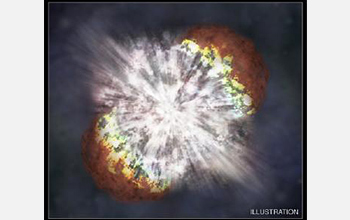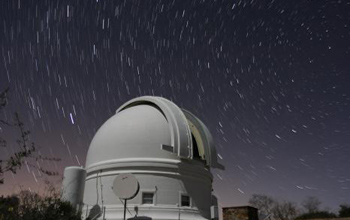All Images
Research News
Not a Quirk But a Quark ... a Quark Star!

Illustration of a supernova explosion. Three exceptionally luminous supernovae explosions have been observed in recent years. One was first observed using a robotic telescope at Caltech's Palomar Observatory. Data collected with Palomar's Samuel Oschin Telescope was transmitted from the remote mountain site in southern California to astronomers via the NSF-funded High-Performance Wireless Research and Education Network (HPWREN). The Nearby Supernova Factory research group at the Lawrence Berkeley Laboratory reported the co-discovery of the supernova, known as SN2005gj. Researchers in Canada have analyzed this, along with two other supernovae, and believe that they each may be the signature of the explosive conversion of a neutron star into a quark star.
Credit: NASA/CXC/M.Weiss
Download the high-resolution JPG version of the image. (42 KB)
Use your mouse to right-click (Mac users may need to Ctrl-click) the link above and choose the option that will save the file or target to your computer.

Palomar Observatory's 48-inch Samuel Oschin Telescope, with the six-foot HPWREN antenna that was used for the 45Mbps link, and which has since been upgraded to an eight-foot antenna in support of 155Mbps (million bits per second) connectivity with the Palomar Observatory.
Credit: Scott Kardel of Caltech / Palomar Observatory
Download the high-resolution JPG version of the image. (18 KB)
Use your mouse to right-click (Mac users may need to Ctrl-click) the link above and choose the option that will save the file or target to your computer.


